
The Nissan Skyline GT-R is a Japanese sports car based on the Nissan Skyline range.
The first GT-Rs were produced from 1969–1977. After a 16 year hiatus since the KPGC110 in 1972, the GT-R name was revived in 1989 with the Skyline R32. This car was nicknamed "Godzilla" by the Australian motoring publication "Wheels" in its July 1989 edition, a name that sticks to this day. The R32 GT-R dominated the motorsport in Japan, winning 29 straight victories out of 29 races. The GT-R proceeded to win the JGTC Group A series championship 4 years in a row, and also had success in the Australian Touring Car Championship winning from 1990–1992, until the GT-R was outlawed in 1993.[1] The Skyline GT-R (R33) was also the first production car to lap the legendary Nürburgring in under eight minutes.
The Skyline GT-R became the flagship of Nissan performance, showcasing many advanced technologies including the ATTESA-ETS 4WD system and the Super-HICAS four-wheel steering. The GT-Rs remained inexpensive compared to its European rivals, with a list-price of ¥4,500,000 (US$31,000). Today, the car is popular for import Drag Racing, Circuit Track, Time Attack and events hosted by tuning magazines. The GT-R is the winner in the 2007 Tsukuba Time Attack held in Japan—the M-Speed GT-R (9 out of the top 15 cars consists of GT-Rs). Production of the Skyline GT-R ended in August 2002. The car was replaced by the GT-R, an independent vehicle not sold as a Skyline.
The Skyline GT-R was never manufactured outside of Japan, and the sole export markets were Hong Kong, Australia and the UK, in 1991,[2] and New Zealand as used Japanese imports. Despite this the car has become an iconic sports car, including in countries from the Western World (mainly the United Kingdom, Australia, New Zealand, Ireland and Canada).[3][4][5] It has become notable through pop culture such as cinema and video games like The Fast and the Furious series, Initial D, Wangan Midnight, and Gran Turismo.
The car was named by BBC's Top Gear as the only true Japanese contribution in the line of supercars.[6] The car was also named by the main presenter of the show, Jeremy Clarkson, as one of the best cars in the world.
The first GT-Rs were produced from 1969–1977. After a 16 year hiatus since the KPGC110 in 1972, the GT-R name was revived in 1989 with the Skyline R32. This car was nicknamed "Godzilla" by the Australian motoring publication "Wheels" in its July 1989 edition, a name that sticks to this day. The R32 GT-R dominated the motorsport in Japan, winning 29 straight victories out of 29 races. The GT-R proceeded to win the JGTC Group A series championship 4 years in a row, and also had success in the Australian Touring Car Championship winning from 1990–1992, until the GT-R was outlawed in 1993.[1] The Skyline GT-R (R33) was also the first production car to lap the legendary Nürburgring in under eight minutes.
The Skyline GT-R became the flagship of Nissan performance, showcasing many advanced technologies including the ATTESA-ETS 4WD system and the Super-HICAS four-wheel steering. The GT-Rs remained inexpensive compared to its European rivals, with a list-price of ¥4,500,000 (US$31,000). Today, the car is popular for import Drag Racing, Circuit Track, Time Attack and events hosted by tuning magazines. The GT-R is the winner in the 2007 Tsukuba Time Attack held in Japan—the M-Speed GT-R (9 out of the top 15 cars consists of GT-Rs). Production of the Skyline GT-R ended in August 2002. The car was replaced by the GT-R, an independent vehicle not sold as a Skyline.
The Skyline GT-R was never manufactured outside of Japan, and the sole export markets were Hong Kong, Australia and the UK, in 1991,[2] and New Zealand as used Japanese imports. Despite this the car has become an iconic sports car, including in countries from the Western World (mainly the United Kingdom, Australia, New Zealand, Ireland and Canada).[3][4][5] It has become notable through pop culture such as cinema and video games like The Fast and the Furious series, Initial D, Wangan Midnight, and Gran Turismo.
The car was named by BBC's Top Gear as the only true Japanese contribution in the line of supercars.[6] The car was also named by the main presenter of the show, Jeremy Clarkson, as one of the best cars in the world.
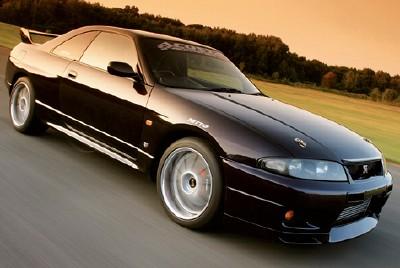
History of the brand
The Skyline name originated from Prince automobile company, which developed and sold the Skyline line of sedans before merging with Nissan-Datsun. The GT-R abbreviation stands for Gran Turismo Racer while the GT-B stands for Gran Turismo Berlinetta. The Japanese chose to use Italian when naming the car – as most cars made in Japan at that time used Western abbreviations – to further enhance sales. The earliest predecessor of the GT-R, the S54 2000 GT-B, came second in its first race in 1964 to the purpose-built Porsche 904 GTS. The next development of the GT-R, the four-door PGC10 2000 GT-R, scored 33 victories in the one and a half years it raced, and by the time it attempted its 50th consecutive win, its run was ended by a Mazda Savanna RX-3. The car took 1000 victories by the time it was discontinued in 1972. The last of the original GT-Rs, the KPGC110 2000GT-R, used an unchanged S20 119 kW (160 hp) inline-6 engine from the earlier 2000 GT-R and only sold 197 units due to the worldwide energy crisis. This model was the only GT-R to never participate in a major race despite the sole purpose-built racecar which now resides in Nissan's storage unit for historical cars in Zama.The Skyline continued into the 1990s when it became popular largely because it remained rear wheel drive, while most other manufacturers were focusing on front wheel drive cars.
Throughout its lifetime, various special editions containing additional performance-enhancing modifications, were released by Nissan and its performance division Nismo (Nissan Motorsport).
Versions

1st generation (1969–1972)
The first Skyline GT-R, known by the internal Nissan designation PGC10, was released on February 4, 1969. It was available originally as a four-door sedan after a public debut at the 15th annual Tokyo Motor Show. It was advertised alongside the Nissan R380A racecar to showcase its racing heraldry. It was equipped with the 2.0 L DOHC S20 I6 producing 160 hp (120 kW) at 7000 rpm and 118 N·m (87 ft·lbf) of torque. Power was delivered to the rear wheels by a 5-speed manual transmission. The first Skyline GT-R rode on a semi-trailing arm strut suspension. It was available as a coupe in March 1971 with the chassis code KPGC10.A popular name for the PGC and KPGC10 Skyline GT-R was "Hakosuka," which is a combination of the Japanese word for box ("hako" or ハコ) and the pronounced abbreviation of skyline ("Suka" or スカ as in スカイライン or "sukairain").
A total of 1,945 PGC and KPGC10 Skyline GT-Rs were produced.
2nd generation (1972–1977)
The KPGC10's successor, the KPGC110, was released in 1973 after its introduction at the 1972 Tokyo motor show. Powered by a 1989 cc I6 S20 engine, the second generation GT-R delivered power to the rear wheels through a 5-speed manual gearbox. The suspension was a semi-trailing ring arm setup and minor aerodynamic parts were added.This edition of the GT-R was also known as the "Ken & Mary" Skyline, due to a popular advertisement featuring a young couple (Ken and Mary) enjoying the Hokkaido countryside. The advertisement later spawned a hit song by Buzz, and the tree featured in the advertisement later became a minor star itself.[citation needed]
Unfortunately, the second generation GT-R was unsuccessful, for a gas crisis hit in the early 1970s, drying out any demand for high-performance sports cars. A total of 197 cars were built by the end of its short production run. For the next decade, this would be the last GT-R until the production of the R32 in 1989.
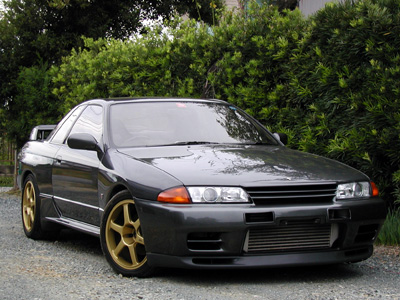
3rd generation (1989–1994)
Concept
After cancelling the Skyline GT-R in 1973, Nissan revived the GT-R again in 1989. At the time Nissan was competing in Group A Racing with the Skyline GTS-R. Nissan wanted to retire the GTS-R in favor of a more competitive vehicle. The new generation GT-R, E-BNR32 chassis (commonly shortened to R32), was designed to dominate Group A racing.Nissan Kohki (Nissan's power train engineering and manufacturing facility) originally tested a twin turbocharged 2350cc bored and stroked version of the RB20 engine. This set up produced 233 kW (313 hp) and used a RWD drivetrain. Under Group A regulations, a turbocharged engine must multiply its engine displacement by 1.7, putting the new Skyline in the 4000 cc class, and requiring the use of 10-inch-wide tires. Knowing that they would be required to use 10-inch-wide tires, Nissan made the decision to make the car all wheel drive. Nissan developed a special motorsport-oriented AWD system for this purpose called the ATTESA E-TS. Although this assisted with traction, it made the car 100 kg (220 lb) heavier; the added weight put the GT-R at a disadvantage to other cars in the 4000 cc class. Nissan then made the decision to increase the displacement to 2600 cc, and put the car in the 4500 cc class, with the car's weight near-equal to competing cars. The 4500 cc class also allowed for 11-inch-wide tires. New engine block and heads were then developed to better match the increased displacement. The result was a 600 horsepower.[9] Later REINIK (Racing & Rally Engineering Division Incorporated Nissan Kohi) produced Group A racing engines between 373–485 kW (500–650 hp)[10] depending on track conditions.
Production
This new 2.6 L all wheel drive concept was put into production as the R32 Nissan Skyline GT-R. The R32 developed 206 kW (276 hp) and 266 lb·ft (361 N·m) of torque, it had a curb weight of 1,430 kg (3,146 lbs). Initial production of the car was the required 510 to allow for homologation starting on May 22, 1989. Its successful debut along with critical acclaim by the motoring press created a heavy demand for the car. Nissan officially started an unlimited production run August 1989, and began its Group A campaign in 1990. Due to strict Group A homologation rules, Nissan was required to also sell a series of the Skyline GT-R which more accurately reflected the car they use in Group A racing. This series was called the Skyline GT-R 'Nismo' edition.The Skyline GT-R 'Nismo', introduced on February 22, 1990, has a total production of 560 units as required for the "Evolution" models regulation (over 500). Its purpose is to homologate a number of aerodynamic changes used in Group A racing. Changes include additional ducts in the front bumper to improve airflow to the intercooler, a bonnet lip spoiler to direct more air into the engine bay, and an additional boot lip spoiler to provide more downforce. The 'Nismo' GT-R was only available in Gunmetal Grey.
The Skyline GT-R 'N1' model, introduced on July 19, 1991, was designed for home-market N1 racing with a total of 228 units produced. The most notable change was in the engine, which was upgraded to the R32-N1 specification. The car was also lightened by the removal of the ABS, air conditioning, sound system, rear wiper, trunk carpet, and the use of light-weight headlights. No color options were available and all 'N1' cars were delivered with a thin layer of Crystal White paint. The result was a 30 kg weight savings for a curb weight of 1,400 kg.
Finally on February 14, 1994 the Skyline GT-R V-Spec II was released, with the only change being wider 245/45/17 tires. In addition, both the V-Spec and V-Spec II had a curb weight of 1,480 kg (3,256 lbs), weighing 50 kg (110 lbs) more than the standard GT-R.[11] Total production of the V-Spec I and II was 1,453 and 1,303 units respectively.
Total production of the R32 Skyline GT-R was 43,394 units, with production starting on May 22, 1989. An above average proportion of the GT-R's were sold in white: this is likely because white is the national racing color of Japan in international motorsport.
4th generation (1995–1998)
The E-BCNR33 (R33) was developed in 1995 as a successor to the venerable R32 model. The engine in the R33 was nearly identical to the R32. It used the same turbochargers and the same specification for the manual gearbox, although the syncros were made to be stronger. The engine corrected the R32's weak oil pump drive collar, which tended to fail in higher power applications, with a wider collar. The base model R33 GT-R weighs 1,540 kg (3,400 lb).[12]The R33 GT-R launched in January 1995 with the base model GT-R and the V-spec model. The V-spec model weighed in 10 kg (22 lb) heavier, and had sportier suspension resulting in lower ground clearance. The V-spec also featured the newer ATTESA E-TS Pro all wheel drive system, which included an Active Limited Slip differential. The V-spec model also included a four wheel independent channel anti-lock braking system.
At the same time as the release of the R33 GT-R and GT-R V-spec, Nissan released the R33 GT-R V-spec N1 model. Changes made in the R33 N1 are similar to those in the R32 N1. The car was made lighter by removing the ABS, air conditioning, sound system, rear wiper and trunk carpet. The R33 GT-R V-spec N1 received the slightly revised R33 N1 engine.
5th generation (1999–2002)
The GT-BNR34 (R34) Skyline GT-R and GT-R V-spec models were released in January 1999. The R34 GT-R was also made to be shorter (from front to rear), and the front overhang was reduced. The valve covers were also painted glossy red, rather than dull black.A new feature on the R34 GT-R is a 5.8" LCD multifunction display on the center of the dashboard, which shows seven different live readings of engine and vehicle statistics such as turbocharger pressure (1.2 bar max), oil and water temperature, among others. The GT-R V-spec model added two extra features to the display: intake and exhaust gas temperatures. Nismo Multi-function Displays (MFD) can be bought at an extra cost, they include a lap timer, G-Force meter and an increase in boost pressure measurement to 2 bar. The R34 GT-R was made shorter in response to customer concerns who thought the R33 was too bulky.
Like the R33, the new R34 GT-R V-Spec (Victory Specification) models come equipped with the ATTESA E-TS Pro system and an Active LSD at the rear, while standard GT-R models come with the non-Pro system and a conventional mechanical differential. The V-spec model also had firmer suspension and lower ground clearance, thanks to front and side splitters, as well as a rear carbon fiber air diffuser, designed to keep air flowing smoothly under the car.
Another special model of the R34 GT-R is the M-spec. It was similar to the V-spec, but had special "Ripple control" dampers, revised suspension set up, stiffer rear sway bar and a leather interior with heated front seats. The 'M' on the M-Spec stood for Mizuno who is the chief engineer of Nissan.
At the time of the R34's release, like the R32 and R33, Nissan released an R34 N1 model. The R34 GT-R N1 was equipped similar to the R32 and R33 N1 models – a homologation special. It was sold without ABS, air conditioning, audio equipment, rear wiper, or trunk lining. The new R34 N1 was also given the new R34 N1 engine. Only 45 R34 N1 models were produced from the factory, 12 of which were used by Nismo for Super Taikyu racing. The rest were sold to various customers, mostly racing teams and tuning garages.
The V-Spec versions was also imported into the UK, a number of modifications was carried out to the car, these were 3 additional oil coolers, revised ECU map, full Connelly leather interior, underbody diffusers, stiffer suspension, active rear limited slip differential, extra display feature on the in car display.





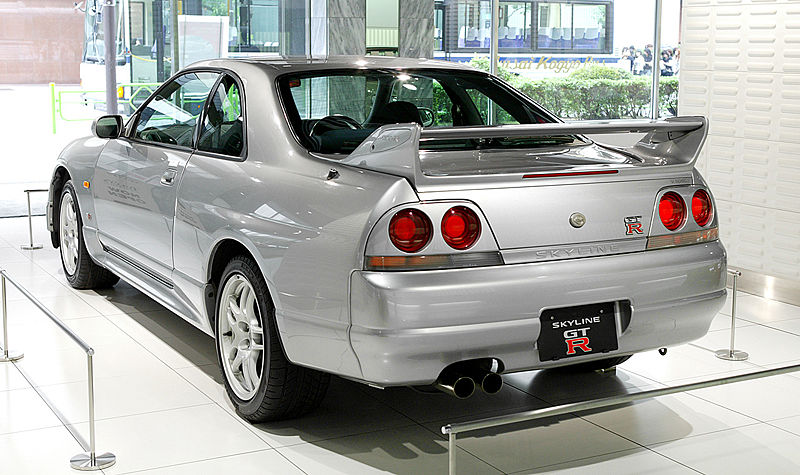
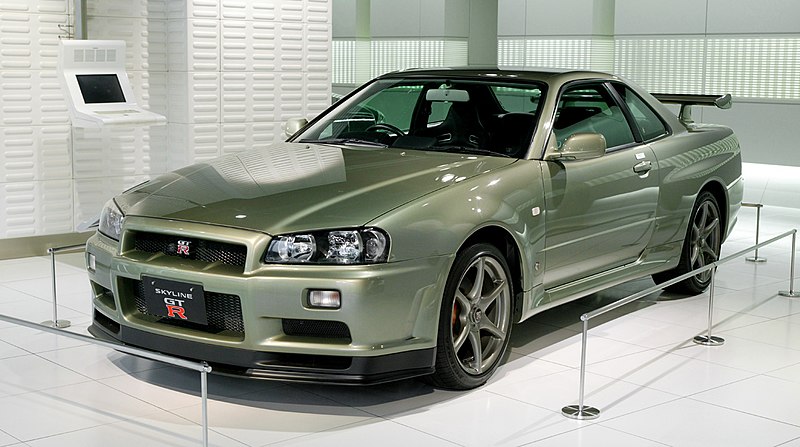
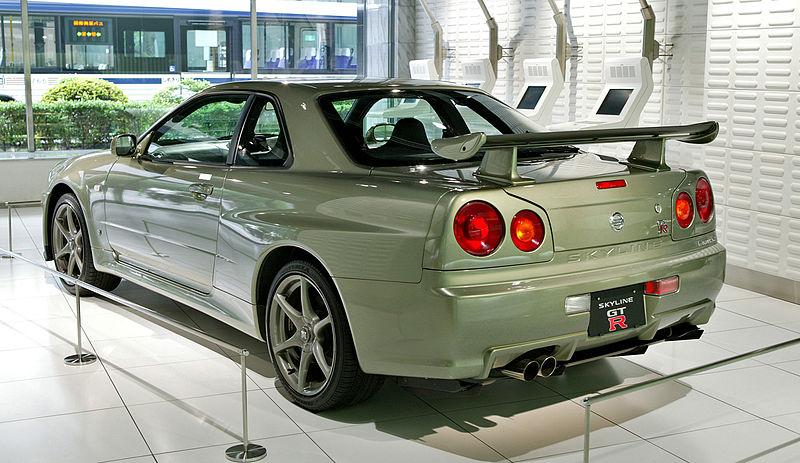
No comments:
Post a Comment